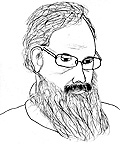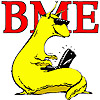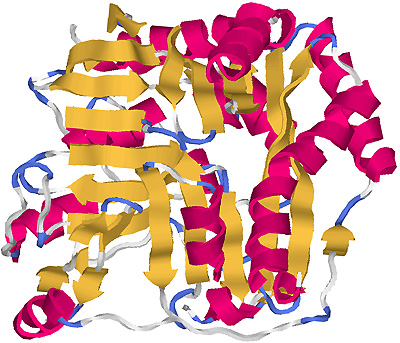
Kevin Karplus's Lab group
(Last Update:
17:43 PDT 13 July 2011
)
This web page is for Kevin Karplus's group in protein-structure
prediction (and, eventually, protein design). The page has not been
fully created yet, so you'll probably find more interesting stuff on
the members' home pages.
Although bioinformatics does not use assigned desk space, the students
in my lab group usually hang out in Physical Sciences Building (PSB) 313.
The School of Engineering Instructor Evaluation extra forms are at
http://compbio.soe.ucsc.edu/soe-extra-questions.html
Old schedules
After each quarter, I move the meeting schedule to old-schedules.html, so that I have a
rough record of what we talked about.
Summer 2011 individual meeting schedule
I am on sabbatical and will be on campus at unpredicatble times
(probably about once a week).
Summer 2011 Group Meetings
Lab meetings will not be held this summer, though we may meet in the
Fall in
PSB
305 despite my being on sabbatical.
Unscheduled papers
- Katja Luck and Gilles Trave
Phage display can select over-hydrophobic sequences that may impair
prediction of natural domain-peptide interactions
Bioinformatics 2011 27: 899-902; doi:10.1093/bioinformatics/btr060
http://bioinformatics.oxfordjournals.org/cgi/content/abstract/27/7/899?etoc
-
Gregory D. Friedland and Anthony J. Linares and Colin A. Smith and
Tanja Kortemme.
"A Simple Model of Backbone Flexibility Improves Modeling of Side-Chain Conformational Variability",
Journal of Molecular Biology 380(4):757–774, 18 July 2008
doi:10.1016/j.jmb.2008.05.006
pmid = 18547586
- sequence-similar, structure-dissimilar
doi:10.1002/prot.21770
-
Rykunov D, Fiser A
New statistical potential for quality assessment of protein models and
a survey of energy functions.
BMC Bioinformatics 2010 11:128
doi:10.1186/1471-2105-11-128
- Rykunov D, Fiser A.
Proteins: Structure, Function, and Bioinformatics Volume 67, Issue 3, pages 559–568, 15 May 2007
Effects of amino acid composition, finite size of proteins, and sparse statistics on distance-dependent statistical pair potentials.
doi: 10.1002/prot.21279
- Hernan Stamati, Cecilia Clementi, Lydia E. Kavraki
Application of nonlinear dimensionality reduction to characterize the conformational landscape of small peptides.
Proteins 2010 Feb 1 78 (2):223-35
doi: 10.1002/prot.22526
-
Raffaello Potestio, Cristian Micheletti, Henri Orland
Knotted vs. Unknotted Proteins: Evidence of Knot-Promoting Loops.
http://www.ploscompbiol.org/article/info:doi/10.1371/journal.pcbi.1000864
-
Michael C. Prentiss, David J. Wales, Peter G. Wolynes
The Energy Landscape, Folding Pathways and the Kinetics of a Knotted Protein
http://www.ploscompbiol.org/article/info:doi/10.1371/journal.pcbi.1000835
- Petros Kountouris and Jonathan D Hirst
Predicting beta-turns and their types using predicted backbone
dihedral angles and secondary structures.
BMC Bioinformatics 2010, 11:407
doi:10.1186/1471-2105-11-407
- Thomas D. Otto, Mandy Sanders, Matthew Berriman, and Chris Newbold
Iterative Correction of Reference Nucleotides (iCORN) using second
generation sequencing technology
Bioinformatics 2010 26(14):1704-1707;
doi:10.1093/bioinformatics/btq269
- Monika Jelizarow, Vincent Guillemot, Arthur Tenenhaus,
Korbinian Strimmer, and Anne-Laure Boulesteix
Over-optimism in bioinformatics: an illustration.
Bioinformatics 2010 26(16):1990-1998;
doi:10.1093/bioinformatics/btq323
- Yongchao Liu, Bertil Schmidt and Douglas L. Maskell
MSAProbs: multiple sequence alignment based on pair hidden Markov
models and partition function posterior probabilities
Bioinformatics 2010 26(16):1958-1964;
doi:10.1093/bioinformatics/btq338
-
Wing-Cheong Wong, Sebastian Maurer-Stroh, Frank Eisenhaber.
More Than 1,001 Problems with Protein Domain Databases: Transmembrane Regions, Signal Peptides and the Issue of Sequence Homology.
http://www.ploscompbiol.org/article/info:doi/10.1371/journal.pcbi.1000867
-
Stephen F. Altschul, John C. Wootton, Elena Zaslavsky, Yi-Kuo Yu.
The Construction and Use of Log-Odds Substitution Scores for Multiple Sequence Alignment.
http://www.ploscompbiol.org/article/info:doi/10.1371/journal.pcbi.1000852
-
Bipasha Barua, Jasper C. Lin, Victoria D. Williams, Phillip Kummler,
Jonathan W. Neidigh, and Niels H. Andersen.
The Trp-Cage: Optimizing the Stability of a Globular Miniprotein.
Protein Engineering, Design & Selection. 2008 March; 21(3):171--185.
doi:10.1093/protein/gzm082
- Csaba G, Birzele F, Zimmer R.
Systematic comparison of SCOP and CATH: a new gold standard for
protein structure analysis.
BMC Struct Biol. 2009; 9: 23.
Published online 2009 April 17. doi: 10.1186/1472-6807-9-23
http://www.ncbi.nlm.nih.gov/pmc/articles/PMC2678134/
-
Michael J. Keiser, Vincent Setola, John J. Irwin, Christian
Laggner, Atheir I. Abbas, Sandra J. Hufeisen, Niels H. Jensen,
Michael B. Kuijer, Roberto C. Matos, Thuy B. Tran, Ryan Whaley,
Richard A. Glennon, Jérôme Hert, Kelan L. H. Thomas, Douglas
D. Edwards, Brian K. Shoichet, Bryan L. Roth
Predicting new molecular targets for known drugs
Nature 462, 175-181 (12 November 2009)
doi:10.1038/nature08506
- Andreeva A, Murzin A.G
Evolution of protein fold in the presence of functional constraints.
Curr Opin Struct Biol. 2006 Jun;16(3):399-408
doi:10.1016/j.sbi.2006.04.003
-
Antonina Andreeva, Andreas Prlic, Tim J. P. Hubbard and Alexey Murzin
SISYPHUS - structural alignments for proteins with non-trivial
relationships
Nucleic Acid Research Database Issue 2007, 35, D253-D259
doi:10.1093/nar/gkl746
- James O. Wrabl, Nick V. Grishin.
Statistics of Random Protein Superpositions: p-Values for Pairwise Structure Alignment
Journal of Computational Biology.
April 2008, 15(3): 317-355.
doi:10.1089/cmb.2007.0161
- Dariusz Przybylski and Burkhard Rost
Powerful fusion: PSI-BLAST and consensus sequences
BIoinformatics 2008, 24(18):1987-1993
doi:10.1093/bioinformatics/btn384
-
Wang M, Caetano-Anollés G
The evolutionary mechanics of domain organization in proteomes and the rise of modularity in the protein world.
Structure 2009 Jan 17 (1):66-78
- Saelensminde G, Halskau Ø, Jonassen I
Amino acid contacts in proteins adapted to different temperatures: hydrophobic interactions and surface charges play a key role.
Extremophiles 2009 Jan 13 (1):11-20
- P. S. Shah, G. K. Hom, S. A. Ross, J. K. Lassila, K. A. Crowhurst
and S. L. Mayo.
Full-Sequence Computational Design and Solution
Structure of a Thermostable Protein Variant.
J. Mol. Biol., 372, 1-6, 2007.
- A. Pluckthun and S. L. Mayo.
The Design of Evolution and the
Evolution of Design.
Curr. Opin. Struct. Biol., 17, 1-3, 2007.
- O. Alvizo, B. D. Allen and S. L. Mayo.
Computational Protein Design Promises to Revolutionize Protein Engineering.
Biotechniques, 42, 31-39, 2007.
- Leiman PG, Molineux IJ.
Evolution of a new enzyme activity from the same motif fold.
Mol Microbiol. 2008 Jul;69(2):287-90.
doi:10.1111/j.1365-2958.2008.06241.x
- Bharat TA, Eisenbeis S, Zeth K, Höcker B
A beta alpha-barrel built by the combination of fragments from different folds.
Proc Natl Acad Sci U S A 2008 Jul 22 105 (29):9942-7
http://www.pnas.org/content/105/29/9942
-
Ivelin Georgiev, Daniel Keedy, Jane S. Richardson, David C. Richardson,
and Bruce R. Donald
Algorithm for backrub motions in protein design
Bioinformatics 2008 24: i196-i204;
doi:10.1093/bioinformatics/btn169
http://bioinformatics.oxfordjournals.org/cgi/content/abstract/24/13/i196?etoc
-
Menachem Fromer and Chen Yanover
A computational framework to empower probabilistic protein design
Bioinformatics 2008 24: i214-i222;
doi:10.1093/bioinformatics/btn168
http://bioinformatics.oxfordjournals.org/cgi/content/abstract/24/13/i214?etoc
- Löytynoja A, Goldman N.
Phylogeny-aware gap placement prevents errors in sequence alignment
and evolutionary analysis.
Science. 2008 Jun 20;320(5883):1632-5.
http://www.sciencemag.org/cgi/content/abstract/320/5883/1632
doi:10.1126/science.1158395
- Xie L, Bourne PE.
Detecting evolutionary relationships across existing fold space,
using sequence order-independent profile-profile alignments.
Proc Natl Acad Sci U S A. 2008 Apr 8;105(14):5441-6. Epub 2008 Apr 2.
- Aleksandar Poleksic and Mark Fienup
Optimizing the size of the sequence profiles to increase the accuracy of
protein sequence alignments generated by profile-profile algorithms
Bioinformatics 2008 24: 1145-1153;
doi:10.1093/bioinformatics/btn097
http://bioinformatics.oxfordjournals.org/cgi/content/abstract/24/9/1145
- A. Su and S. L. Mayo
Coupling backbone flexibility and amino acid sequence selection in
protein design
Protein Science, Vol 6, Issue 8 1701-1707
- Christopher T. Saunders and David Baker
Recapitulation of Protein Family Divergence using Flexible Backbone Protein Design
Journal of Molecular Biology
Volume 346, Issue 2, 18 February 2005, Pages 631-644
doi:10.1016/j.jmb.2004.11.062
-
David R. Westhead, Timothy W.F. Slidel, Tomas P.J. Flores, and Janet M. Thornton.
Protein structural topology: Automated analysis and diagrammatic representation.
Protein Science (1999), 8: 897-904
http://journals.cambridge.org/action/displayAbstract?fromPage=online&aid=45405
-
Jane S. Richardson and David C. Richardson.
Natural beta-sheet proteins use negative design to avoid edge-to-edge aggregation.
PNAS 99(5):2754-2759, March 5, 2002.
http://www.pnas.org/cgi/content/full/99/5/2754
-
Yan, Y. and Moult, J.
Protein family clustering for structural genomics
Journal of Molecular Biology, 353, 744-759 (2005)
doi:10.1016/j.jmb.2005.08.058
-
Dalton et al.
title?
Bioinformatics 19(10):1298-9 (2005)
doi:10.1093/bioinformatics/btg141
- Lee and Chirikjian.
title?
Biophys J 86(2):1105-1117, (2003).
(correction published (2004). Biophys J 86(4):2634)
doi:?
-
Walther, Springer, and Cohen
Helix-helix packing angle preferences for finite helix axes.
Proteins 33(4):457-459, (1998).
doi:10.1002/(SICI)1097-0134(19981201)33:4<457::AID-PROT1>3.0.CO;2-L
(This is the paper from after Walther and Bowie agreed
that this would have been the most appropriate null model to use.
Martin M. and Kevin are not sure that they are right in reporting the
propensities---the null model has zero probability for some of their
rarely observed results, which resulted in enormous propensity for
rare states!)
- Walther, Eisenhaber, and Argos.
title?
J Mol Biol 255:536-553, (1996).
doi?
-
Bowie.
title?
Nature Struct Biol 4:915-917, (1997).
doi?
-
Pawel Smialowski, Antonio J. Martin-Galiano, Aleksandra Mikolajka, Tobias
Girschick, Tad A. Holak, and Dmitrij Frishman.
Protein solubility: sequence based prediction and experimental
verification
Bioinformatics 23: 2536-2542, (2007).
http://bioinformatics.oxfordjournals.org/cgi/content/abstract/23/19/2536
-
Schaffer, A.A., Aravind, L., Madden, T.L., Shavirin, S., Spouge, J.L.,
Wolf, Y.I., Koonin, E.V., Altschul, S.F.
Improving the accuracy of PSI-BLAST protein database searches with
composition-based statistics and other refinements.
Nucleic Acids Research, 29, 14:2994-3005 (2001)
http://nar.oxfordjournals.org/cgi/content/full/29/14/2994
-
Yu, Y.K., Wootton, J.C., Altschul, S.F.
The compositional adjustment of amino acid substitution matrices.
Proceedings of the National Academy of Sciences, 100, 26:15688--15693 (2003).
http://www.pnas.org/cgi/content/full/100/26/15688
doi:10.1073/pnas.2533904100
-
Altschul, S.F., Wootton, J.C., Gertz, E.M., Agarwala, R., Morgulis,
A., Schaffer, A.A., Yu, Y.K.
Protein database searches using compositionally adjusted substitution matrices.
FEBS Journal, 272, 20:5101-5109 (2005)
http://www.blackwell-synergy.com/doi/abs/10.1111/j.1742-4658.2005.04945.x
doi:10.1111/j.1742-4658.2005.04945.x
-
Yu, Y.K., Altschul, S.F.
The construction of amino acid substitution matrices for the
comparison of proteins with non-standard compositions.
Bioinformatics, 21, 7:902-911 (2005)
http://bioinformatics.oxfordjournals.org/cgi/content/full/21/7/902
doi:10.1093/bioinformatics/bti070
-
Yu, Y.K., Gertz, E.M., Agarwala, R., Schaffer, A.A., Altschul, S.F.
Retrieval accuracy, statistical significance and compositional
similarity in protein sequence database searches.
Nucleic Acids Research, 34, 20:5966-5973 (2006)
http://nar.oxfordjournals.org/cgi/content/full/34/20/5966
doi:10.1093/nar/gkl731
-
Milana Frenkel-Morgenstern, Rachel Magid, Eran Eyal, and Shmuel Pietrokovski.
Refining intra-protein contact prediction by graph analysis
BMC Bioinformatics. 2007; 8(Suppl 5): S6.
Published online 2007 May 24.
doi:10.1186/1471-2105-8-S5-S6
- Michael J. Sweredoski, Kevin J. Donovan, Bao D. Nguyen, A.J. Shaka, and
Pierre Baldi
Minimizing the overlap problem in protein NMR: a computational framework
for precision amino acid labeling
Bioinformatics 2007 23: 2829-2835.
http://bioinformatics.oxfordjournals.org/cgi/content/abstract/23/21/2829
- Hung-Pin Peng and An-Suei Yang.
Modeling protein loops with knowledge-based prediction of
sequence-structure alignment.
Bioinformatics 2007 23: 2836-2842.
http://bioinformatics.oxfordjournals.org/cgi/content/abstract/23/21/2836
- Frank DiMaio, Dmitry A. Kondrashov, Eduard Bitto, Ameet Soni, Craig A.
Bingman, George N. Phillips, Jr, and Jude W. Shavlik.
Creating protein models from electron-density maps using
particle-filtering methods.
Bioinformatics 2007 23: 2851-2858.
http://bioinformatics.oxfordjournals.org/cgi/content/abstract/23/21/2851
Register for class
Graduate students attending the protein structure club and lab group
meetings should register for BME 281K (Seminar on Protein Structure
Prediction). This is in addition to any independent study or thesis
work they are doing with me.
Current projects
There are always more projects to do than people to do them.
I used to keep a partial list of projects that need doing at
http://www.soe.ucsc.edu/~karplus/protein-projects.html
but I have not been keeping it up to date.
Instead, I've been creating lists for the BME 220 (Protein
Informatics) class:
The older lists may still contain viable projects that I have not
brought forward to the newer lists.
Lab Members
- Kevin Karplus
-
 Professor of Biomolecular Engineering, head of lab,
master programmer for undertaker, predict-2nd, estimate-dist,
correlated-columns, and C++ library.
Professor of Biomolecular Engineering, head of lab,
master programmer for undertaker, predict-2nd, estimate-dist,
correlated-columns, and C++ library.
- Richard Hughey
-
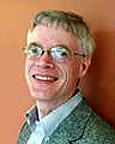 Professor of Computer Engineering, master programmer for SAM tool suite.
Professor of Computer Engineering, master programmer for SAM tool suite.
- Dietlind Gerloff
- Assistant Professor of Biomolecular Engineering, predicting
function using structure
- John Archie
 Started as rotation student W07. Worked on including predicted
burial, bys, and protein-block local structure alphabets into
undertaker cost function. Getting into protein design.
Started as rotation student W07. Worked on including predicted
burial, bys, and protein-block local structure alphabets into
undertaker cost function. Getting into protein design.
Richard's students
Dietlind's students
- Jon Magasin

- Herbert Lee

- Chris Wilks
- CS master's student, Winter 2010.
- Felicia Kemp
- Undergrad, Winter 2010–
- Edward Liaw
 Rotation student with Dietlind, Fall 2010.
Rotation student with Dietlind, Fall 2010.
Research Topics
The lab mainly works on protein-structure prediction, though we hope
to get into protein design in the near future. We work on almost all
aspects of protein-structure prediction including remote homology
detection using interated search and hidden Markov models, alignment
of sequences to structures using multi-track hidden Markov models,
prediction of local structure properties using neural nets, prediction
of residue contacts using mutual information, and tertiary structure
prediction using conformation generation and scoring.
We have participated in all but the first of the CASP (Critical Assessment of
Structure Prediction) experiments and have done well in
CASP2,
CASP3,
CASP4,
CASP5,
CASP6,
CASP7, and
CASP8.
All our working notes and files for CASP6, CASP7, and CASP8 are available on the web at
http://www.soe.ucsc.edu/~karplus/casp6
http://www.soe.ucsc.edu/~karplus/casp7
http://www.soe.ucsc.edu/~karplus/casp8
Publications
Publications are mainly on Kevin Karplus's paper list.
Software and services available
Released Software:
We currently have two software packages available:
- SAM
- The premier suite of hidden Markov Model tools, originally
created by Anders Krogh, extended and maintained by Richard Hughey.
- gen_sequence
- Open-source (C) code for generating random sequences, also includes
generating random numbers from beta and Gaussian distributions, and
random vectors from mixtures of Dirichlet distributions.
Unreleased Software: (pointers needed for UCSC access only)
We hoped to be able to distribute the following software in the near
future, but NIH turned down a grant application to fix them up enough
to make them open-source, so it is not clear when we'll have the spare
resources to do it. In the meantime, we are allowing access to the
uncleaned-up code, for those with the fortitude to modify, install,
and compile it themselves without assistance from us:
- "ultimate" C++ class library http://compbio.soe.ucsc.edu/~karplus/ultimate
- undertaker http://compbio.soe.ucsc.edu/~karplus/undertaker
- predict-2nd http://compbio.soe.ucsc.edu/~karplus/predict-2nd
- estimate-dist http://compbio.soe.ucsc.edu/~karplus/estimate-dist
- correlated-columns (sorry, even my copy isn't up to date---I hope
to have time to copy it from the grad student and check it in Spring 2009).
Web Services and databases
-
SAM-T08 alignment, HMM, database query,
secondary structure predictions, residue-residue contact
prediction, 3D-structure prediction
-
UCSC's SAM-T08 method for iterative SAM HMM
construction and remote homology detection and protein structure
prediction updates SAM-T06 by using more sensitive iterated search,
more local structure prediction, residue-residue contact
prediction, and full 3D structure prediction.
information in its scoring functions.
SAM-T02, SAM-T06, SAM-T08 were all server entries to CASP8, and
SAM-T08 was by far the best of the three.
Submit a target protein sequence in FASTA format and receive
a web page full of predictions.
This is our current best-performing server.
-
SAM-T06 alignment, HMM, database query,
secondary structure predictions, residue-residue contact
prediction, 3D-structure prediction
-
UCSC's SAM-T06 method for iterative SAM HMM
construction and remote homology detection and protein structure
prediction updates SAM-T02 by using more sensitive iterated search,
more local structure prediction, residue-residue contact
prediction, and full 3D structure prediction.
information in its scoring functions.
SAM-T99, SAM-T02, and SAM-T06 were all server entries to CASP7, and
SAM-T06 was the best of the three, but has been superceded by SAM-T08.
This site is obsolete and is maintained only for historical comparison.
-
SAM-T02 alignment, HMM, database query,
secondary structure predictions and more
-
UCSC's SAM-T02 method for iterative SAM HMM
construction and remote homology detection and protein structure
prediction updates SAM-T99 by using predicted secondary structure
information in its scoring functions. Both SAM-T99 and SAM-T02 are
"automatic" entries to CASP5 and CASP6.
Submit a target protein sequence in FASTA format and receive
SAM-T02 alignment, HMM, protein database query,
secondary structure predictions, sequence logos
and pairwise alignments of target to top database hits.
This site is obsolete and is maintained only for historical comparison.
-
Yeast protein predictions
- We have pre-computed SAM-T02
predictions for all the ORFs of S. cerervisiae, and created
a web page similar to the results returned by the SAM-T02 server.
The web pages are not currently indexed---to find a protein like
YBL008W you have to go to the subdirectory YBL0/YBL008W and get
the
summary.html file.
We update some of the yeast predictions
each year, based on new structures released in PDB.
Some of the newer updates use the SAM-T06 protocol.
- SAM-T99 alignment, HMM, protein database query,
and secondary structure prediction
-
This site has been turned off, as it was too difficult to maintain
every time we changed any software on the cluster.
It accepted a protein sequence (or alignment) in FASTA format and returned
SAM-T99 alignment, HMM, database hits, and secondary structure prediction.
Lab Alumnæ and Alumni
This list is not really complete. I have only recently started
keeping the list, and my memory is notoriously poor. I know I have
omitted many undergrads who worked with me, and I relied on
publication lists to try to get the complete list of grad students who
worked with me, so anyone who didn't publish probably got overlooked.
I've also limited the list to bioinformatics projects, omitting
students who worked with me back when I did VLSI design and CAD for
VLSI.
- Rasmus Fonseca
 Visiting grad student from Pawel Winter's lab in Copenhagen.
Sept 2010–June 2011.
Visiting grad student from Pawel Winter's lab in Copenhagen.
Sept 2010–June 2011.
- George Shackelford
-
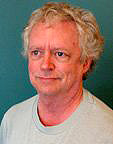 PhD student in bioinformatics, contact prediction in proteins.
Participated in CASP7. Finished PhD in 2010.
PhD student in bioinformatics, contact prediction in proteins.
Participated in CASP7. Finished PhD in 2010.
- Grant Thiltgen
-
 MS/Phd student in bioinformatics.
Summer 2005-Summer 2010. Tested new
local-structure alphabets.
Participated in CASP7. Finished PhD in 2010.
MS/Phd student in bioinformatics.
Summer 2005-Summer 2010. Tested new
local-structure alphabets.
Participated in CASP7. Finished PhD in 2010.
- Alex Atkins
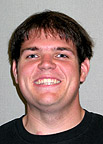 Started as an undergrad in Winter 2008 in BME 220, worked with
Richard Hughey
to get HMM-HMM scoring and alignment working in SAM's hmmscore.
Finished MS in 2010.
Started as an undergrad in Winter 2008 in BME 220, worked with
Richard Hughey
to get HMM-HMM scoring and alignment working in SAM's hmmscore.
Finished MS in 2010.
- Thomas Juettemann
 Dietlind's student from Edinburgh, visiting UCSC July
2007–Sept 2010.
Dietlind's student from Edinburgh, visiting UCSC July
2007–Sept 2010.
- Philip Heller
 Rotation with Dietlind and Josh Stuart jointly, Winter 2010.
Rotation with Dietlind and Josh Stuart jointly, Winter 2010.
- Chris Brumbaugh
 Rotation with Karplus, Winter 2010, working on prediction tools for CASP9.
Rotation with Karplus, Winter 2010, working on prediction tools for CASP9.
- Lynn Olson
 Did a rotation with Dietlind Fall 2009.
Did a rotation with Dietlind Fall 2009.
- Josue Samayoa
 PhD student (inherited from Carol
Rohl's lab). Worked with Carol on using residual dipolar coupling
data to aid in choosing alignments of targets to templates.
Worked with Fitnat Yldiz on simple repeats and short proteins in
Vibrio cholerae.
Finished PhD, July 2009.
Thesis title:" A comparative genomic analysis of simple repeat
motifs and short proteins in prokaryotes."
Gone to work as postdoc in Rachel Karchin's lab.
PhD student (inherited from Carol
Rohl's lab). Worked with Carol on using residual dipolar coupling
data to aid in choosing alignments of targets to templates.
Worked with Fitnat Yldiz on simple repeats and short proteins in
Vibrio cholerae.
Finished PhD, July 2009.
Thesis title:" A comparative genomic analysis of simple repeat
motifs and short proteins in prokaryotes."
Gone to work as postdoc in Rachel Karchin's lab.
- Chirag X. Sharma
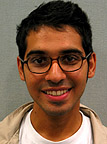 Started as an undergrad June 2008, learning to do protein structure
prediction for CASP8. Started working on Pyrobaculum aerophilum
proteins (Pryobaculum-specific proteins) August 2008.
Started as an undergrad June 2008, learning to do protein structure
prediction for CASP8. Started working on Pyrobaculum aerophilum
proteins (Pryobaculum-specific proteins) August 2008.
- Hyunsung John Kim
 Started as a Masters student Spring 2008, after BME 220 as an
undergrad in Spring 2007. Made some modifications to undertaker for
analyzing packing of aromatic rings in BME 220 project, did some work on per-residue model quality assessment using undertaker.
Moved to Nader Pourmand's lab.
Started as a Masters student Spring 2008, after BME 220 as an
undergrad in Spring 2007. Made some modifications to undertaker for
analyzing packing of aromatic rings in BME 220 project, did some work on per-residue model quality assessment using undertaker.
Moved to Nader Pourmand's lab.
- Steven Hobbs
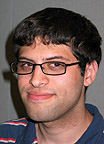 Started as an undergrad Winter 2008, worked on trying to get Rprop
implemented in predict-2nd.
Started as an undergrad Winter 2008, worked on trying to get Rprop
implemented in predict-2nd.
- Javier Castellanos
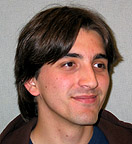 Visiting grad student from University of Chile, mid-Jan to mid-March 2009.
Javier worked on the Qcost cost functions for undertaker (comparing
models based on differences in distances).
He also started work in undertaker to convert CA-only models to
full-atom models.
Visiting grad student from University of Chile, mid-Jan to mid-March 2009.
Javier worked on the Qcost cost functions for undertaker (comparing
models based on differences in distances).
He also started work in undertaker to convert CA-only models to
full-atom models.
- Allison Weis
 SURF-IT student 23 June 2008–22 August 2008.
Worked on GPCR charge distribution for Glen Milhauser and malarial
proteins for Dietlind Gerloff.
SURF-IT student 23 June 2008–22 August 2008.
Worked on GPCR charge distribution for Glen Milhauser and malarial
proteins for Dietlind Gerloff.
- Firas Khatib
-
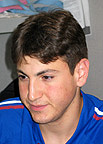 PhD student (inherited from Carol Rohl's lab).
Participated in CASP6 with Carol, CASP7 with me. Did a tiny bit
in CASP8.
Finished thesis on finding knots and slip-knots in protein conformations
generated by structure prediction methods on 30 July 2008.
Thesis title: "Topological Filters for use with Protein Structure Prediction".
Gone for a postdoc in David Baker's lab.
PhD student (inherited from Carol Rohl's lab).
Participated in CASP6 with Carol, CASP7 with me. Did a tiny bit
in CASP8.
Finished thesis on finding knots and slip-knots in protein conformations
generated by structure prediction methods on 30 July 2008.
Thesis title: "Topological Filters for use with Protein Structure Prediction".
Gone for a postdoc in David Baker's lab.
- Martin Madera
-
 Postdoc from May 2006 to Apr 2008.
Participated in CASP7.
Mainly spent his time writing grant proposals in an
unsuccessful attempt to get some stable funding for himself.
Revamped our fold-recognition and alignment tests.
Went to a postdoc with Julian Gough, who had
more stable funding.
Postdoc from May 2006 to Apr 2008.
Participated in CASP7.
Mainly spent his time writing grant proposals in an
unsuccessful attempt to get some stable funding for himself.
Revamped our fold-recognition and alignment tests.
Went to a postdoc with Julian Gough, who had
more stable funding.
- Martin Paluszewski
 Pawel Winter's student from Denmark, visited UCSC for 6 months,
starting July 2007. Worked on extracting constraints from
alignments, and his methods were tested in CASP8 as the
SAM-T08-MQAO model-quality assessment. They were also part of the
SAM-T08-MQAU and SAM-T08-MQAC methods. Started a postdoc in
Anders Krogh's lab.
Pawel Winter's student from Denmark, visited UCSC for 6 months,
starting July 2007. Worked on extracting constraints from
alignments, and his methods were tested in CASP8 as the
SAM-T08-MQAO model-quality assessment. They were also part of the
SAM-T08-MQAU and SAM-T08-MQAC methods. Started a postdoc in
Anders Krogh's lab.
- Joanna Sharman
 Dietlind's student from Edinburgh, visited UCSC for a short time
starting August 2007.
Dietlind's student from Edinburgh, visited UCSC for a short time
starting August 2007.
- Pinal Kanabar
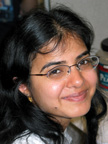 MS student.
Started work on testing a new
H-bond-based local-structure alphabet in Spring 2005 as
prospective student (now Grant's project).
Participated parttime in CASP7.
MS student.
Started work on testing a new
H-bond-based local-structure alphabet in Spring 2005 as
prospective student (now Grant's project).
Participated parttime in CASP7.
- Greg Dougherty
- MS student. Working on interfacing ProteinShop and undertaker
(mainly as BME 220 project, W06).
- Zack Sanborn
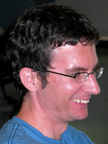 PhD student. Lab rotation Winter 06, worked on protein design
using back-propagation in neural nets and RosettaDesign.
Participated parttime in CASP7.
PhD student. Lab rotation Winter 06, worked on protein design
using back-propagation in neural nets and RosettaDesign.
Participated parttime in CASP7.
- Chris Wong
 MS student. Worked on sequence recovery testing of Design1st in Predict-2nd.
Participated parttime in CASP7.
MS student. Worked on sequence recovery testing of Design1st in Predict-2nd.
Participated parttime in CASP7.
- Mark Mitchell
- PhD student. Lab rotation Winter 06, worked on confirming that
gamma distribution was appropriate for mutual information null model.
(deceased)
- Oscar Hur, PhD (postdoc, roughly 2002-2005)
- Published paper on converting hydrogen distance
restraints into heavy-atom constraints.
Working on an HMM for detecting and aligning TIM barrels.
- Sol Katzman
- bioinformatics grad student---worked for group for CASP6
(Jan-Sept 2005), but has chosen a different lab after first-year rotations.
- Wing Wong (2004-2005)
- MS student in CS at San Jose State. Worked on profile-profile
alignment in SAM, but decided to stick with CS.
- Jes Frellsen
- undergraduate from Denmark (Winter+Spring 2005). Worked on using backpropagation in
local-structure neural nets to do protein design.
- NavyaSwetha Davuluri
 Undergrad. Working on tuning undertaker cost function for
rotamer optimization. Participated in CASP7.
Undergrad. Working on tuning undertaker cost function for
rotamer optimization. Participated in CASP7.
- Erich Blume
- Undergrad. Working on tuning undertaker cost function for
rotamer optimization.
- Sylvia Do
 Undergrad. Participated in CASP7.
Undergrad. Participated in CASP7.
- Crissan Harris.
-
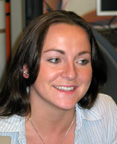 Undergrad. SURF-IT student. Participated in CASP7.
Undergrad. SURF-IT student. Participated in CASP7.
- Cynthia Hsu.
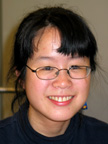 Undergrad. SURF-IT student. Participated in CASP7.
Undergrad. SURF-IT student. Participated in CASP7.
- Suma Potluri
- MS student in computer science.
Started project in W06 on converting neural-net probability vector output for
burial alphabet to continuous prediction for burial
- Ron Chao
- bioinformatics grad student. Winter 2005. Was going to look at
template or alignment selection for close homologs, but drifted
off to other labs.
- Cameron Reid
- has BS in biology and CS from UCSC. Took BME 100.
Spring 2005.
Started working on using inverse kinematics to do "wiggling without
breaking" as a conformation-change operator in undertaker, but
drifted off before implementing anything.
- Carl Gorringe
- Undergraduate (inherited from Carol Rohl's lab).
Winter 2005.
Started working on a project with David Bernick to predict functional
residues from differences in conservation between homologs and
"morphologs", but dropped the project due to overload.
- Chris Dragon
- Computer science undergrad, Fall 2003. Rewrote a2m2html, adding
links to NIH for sequences and taxonomy.
- Rachel Karchin
- A UCSC undergrad and grad student. worked on CASP4 and CASP5. Finished her PhD under
Karplus's supervision in June 2003.
Thesis title: "Local Statistical Dependencies in Protein Structure:
Discovery, Evaluation, Prediction and Applications".
Did a couple of years as a postdoc
in Šali's lab at UCSF, then got a faculty position at
Johns Hopkins.
- Christian Barrett
- Finished his PhD under Karplus's supervision in Sept. 2001.
"Investigation of non-pairwise protein structure score functions using
Thesis title: sets of decoy structures".
Worked for a year in Iceland and is currently doing a postdoc in
Palsson's lab at UCSD.
Participated in CASP-2 and CASP-3.
- Melissa Cline
- jointly advised with David Haussler and Lydia Gregoret, worked with Karplus on
several projects. Finished her PhD in June 2000.
Participated in CASP-2 and CASP-3.
Thesis title: "Protein Sequence Alignment Reliability: Prediction and Measurement".
- Kimmen
Sjölander
- jointly advised with David Haussler, but worked with Karplus on
several projects. Finished her PhD in 1997. Currently on the faculty at
UC Berkeley. Participated in CASP-2.
- Leslie Grate
- advised by Richard Hughey, did at least one project with Karplus
(finding homolog of mamalian antizyme in S. pombe, but not S. cerevisiae).
Finished his PhD in 1999.
Thesis title: "Computer Analysis of RNA".
Did a postdoc at Lawrence Berkeley Lab, then one in Manny's lab at UCSC.
Provided some software for CASP-2 and CASP-3.
- Mark Diekhans
- advised by David Haussler, but has provided some software support
for the Karplus lab, mainly in the form of scripts for downloading and
parsing PDB files. Has also worked on secondary-structure prediction
using posterior decoding of HMMs.
- Sugato Basu
- Finished his Master's degree in 2000. Worked on the Transform
class in the C++ library and some other fundamental code for the
undertaker program. Now in Raymond Mooney's machine-learning
group at UT Austin, working on semi-supervised clustering, both of
text and microarray data, PhD expected summer 2005.
- Birong Hu
- Finished her master's degree in 2000. Worked on using BaliBase to
test SAM-T99 as a multiple-alignment method. Had a prior PhD in
biology from UCLA.
- David Lin
- jointly advised by Haussler. Finished his Masters in 1999,
worked with Karplus on converting protein HMMs to models for searching
EST databases.
- Pernille Nielsen
- a visiting grad student (Oct 04-Feb 05), from Anders Krogh's lab
in Denmark. Working on support-vector machines and HMMs to
classify short ORFs as protein-coding or non-protein coding.
- Marcia Soriano
- bioinformatics senior, evaluating secondary-structure predictors.
Graduated March 05.
- Bret Barnes, undergrad
- bioinformatics senior, track weighting for multi-track HMMs to
optimize alignment. Graduated 2005.
- Adetunde Famakinwa Adekunle (Tunde).
- Undergrad summer 2005.
Worked on training local-structure nerual nets.
- Rudy Ortegon.
- Undergrad summer 2005.
Worked on implementing priority queues.
- Mamie Jallow
- Undergrad from Univ of Washington. summer 2005.
Worked on structure predictions for extracellular domains of
chemotaxis proteins from Vibrio cholerae.
- Don Speck
- Don was never officially part of the Karplus group, but did a lot
of work across the hall in the Kestrel lab and frequently interacted
with Richard Hughey and Kevin Karplus. One of his projects (on
reduced-space sequence alignment) was particularly important to the
SAM suite. He is now working as a VLSI designer.
- Martina Koeva
- bioinformatics grad student, currently working in Josh Stuart's lab.
Participated in CASP-6 predictions.
- Jenny Draper
- bioinformatics grad student, currently working in Karen Ottemann's lab.
Participated in CASP-5 and CASP-6.
- Jonathan Casper
- computer engineering grad student.
Participated in CASP-5. Did some work on scoring hydrogen bonds.
- Spencer Tu
- Worked on a general HMM program for several years.
Architect of the SAM-T99 web service.
Participated in CASP-4.
- Scot Kennedy
- Undergraduate, 2002?. Wrote initial version of a2m2html.
- Yael Mandel-Gutfreund
- Was a postdoc for Lydia Gregoret, but supervised by Karplus for a
year after Gregoret left UCSC. Created the str and str2 local
structure alphabets. Participated in CASP-5. Now on the faculty at the Technion Institute of
Technology.
Questions about page content should be directed to
Kevin Karplus
Biomolecular Engineering
University of California, Santa Cruz
Santa Cruz, CA 95064
USA
karplus@soe.ucsc.edu
1-831-459-4250
318 Physical Sciences Building

 Professor of Biomolecular Engineering, head of lab,
master programmer for undertaker, predict-2nd, estimate-dist,
correlated-columns, and C++ library.
Professor of Biomolecular Engineering, head of lab,
master programmer for undertaker, predict-2nd, estimate-dist,
correlated-columns, and C++ library.
 Professor of Computer Engineering, master programmer for SAM tool suite.
Professor of Computer Engineering, master programmer for SAM tool suite.
 Started as rotation student W07. Worked on including predicted
burial, bys, and protein-block local structure alphabets into
undertaker cost function. Getting into protein design.
Started as rotation student W07. Worked on including predicted
burial, bys, and protein-block local structure alphabets into
undertaker cost function. Getting into protein design.



 Rotation student with Dietlind, Fall 2010.
Rotation student with Dietlind, Fall 2010.
 Visiting grad student from Pawel Winter's lab in Copenhagen.
Sept 2010–June 2011.
Visiting grad student from Pawel Winter's lab in Copenhagen.
Sept 2010–June 2011.
 PhD student in bioinformatics, contact prediction in proteins.
Participated in CASP7. Finished PhD in 2010.
PhD student in bioinformatics, contact prediction in proteins.
Participated in CASP7. Finished PhD in 2010.
 MS/Phd student in bioinformatics.
Summer 2005-Summer 2010. Tested new
local-structure alphabets.
Participated in CASP7. Finished PhD in 2010.
MS/Phd student in bioinformatics.
Summer 2005-Summer 2010. Tested new
local-structure alphabets.
Participated in CASP7. Finished PhD in 2010.
 Started as an undergrad in Winter 2008 in BME 220, worked with
Richard Hughey
to get HMM-HMM scoring and alignment working in SAM's hmmscore.
Finished MS in 2010.
Started as an undergrad in Winter 2008 in BME 220, worked with
Richard Hughey
to get HMM-HMM scoring and alignment working in SAM's hmmscore.
Finished MS in 2010.
 Dietlind's student from Edinburgh, visiting UCSC July
2007–Sept 2010.
Dietlind's student from Edinburgh, visiting UCSC July
2007–Sept 2010.
 Rotation with Dietlind and Josh Stuart jointly, Winter 2010.
Rotation with Dietlind and Josh Stuart jointly, Winter 2010.
 Rotation with Karplus, Winter 2010, working on prediction tools for CASP9.
Rotation with Karplus, Winter 2010, working on prediction tools for CASP9.
 Did a rotation with Dietlind Fall 2009.
Did a rotation with Dietlind Fall 2009.
 PhD student (inherited from Carol
Rohl's lab). Worked with Carol on using residual dipolar coupling
data to aid in choosing alignments of targets to templates.
Worked with Fitnat Yldiz on simple repeats and short proteins in
Vibrio cholerae.
Finished PhD, July 2009.
Thesis title:" A comparative genomic analysis of simple repeat
motifs and short proteins in prokaryotes."
Gone to work as postdoc in Rachel Karchin's lab.
PhD student (inherited from Carol
Rohl's lab). Worked with Carol on using residual dipolar coupling
data to aid in choosing alignments of targets to templates.
Worked with Fitnat Yldiz on simple repeats and short proteins in
Vibrio cholerae.
Finished PhD, July 2009.
Thesis title:" A comparative genomic analysis of simple repeat
motifs and short proteins in prokaryotes."
Gone to work as postdoc in Rachel Karchin's lab.
 Started as an undergrad June 2008, learning to do protein structure
prediction for CASP8. Started working on Pyrobaculum aerophilum
proteins (Pryobaculum-specific proteins) August 2008.
Started as an undergrad June 2008, learning to do protein structure
prediction for CASP8. Started working on Pyrobaculum aerophilum
proteins (Pryobaculum-specific proteins) August 2008.
 Started as a Masters student Spring 2008, after BME 220 as an
undergrad in Spring 2007. Made some modifications to undertaker for
analyzing packing of aromatic rings in BME 220 project, did some work on per-residue model quality assessment using undertaker.
Moved to Nader Pourmand's lab.
Started as a Masters student Spring 2008, after BME 220 as an
undergrad in Spring 2007. Made some modifications to undertaker for
analyzing packing of aromatic rings in BME 220 project, did some work on per-residue model quality assessment using undertaker.
Moved to Nader Pourmand's lab.
 Started as an undergrad Winter 2008, worked on trying to get Rprop
implemented in predict-2nd.
Started as an undergrad Winter 2008, worked on trying to get Rprop
implemented in predict-2nd.
 Visiting grad student from University of Chile, mid-Jan to mid-March 2009.
Javier worked on the Qcost cost functions for undertaker (comparing
models based on differences in distances).
He also started work in undertaker to convert CA-only models to
full-atom models.
Visiting grad student from University of Chile, mid-Jan to mid-March 2009.
Javier worked on the Qcost cost functions for undertaker (comparing
models based on differences in distances).
He also started work in undertaker to convert CA-only models to
full-atom models.
 SURF-IT student 23 June 2008–22 August 2008.
Worked on GPCR charge distribution for Glen Milhauser and malarial
proteins for Dietlind Gerloff.
SURF-IT student 23 June 2008–22 August 2008.
Worked on GPCR charge distribution for Glen Milhauser and malarial
proteins for Dietlind Gerloff.
 PhD student (inherited from Carol Rohl's lab).
Participated in CASP6 with Carol, CASP7 with me. Did a tiny bit
in CASP8.
Finished thesis on finding knots and slip-knots in protein conformations
generated by structure prediction methods on 30 July 2008.
Thesis title: "Topological Filters for use with Protein Structure Prediction".
Gone for a postdoc in David Baker's lab.
PhD student (inherited from Carol Rohl's lab).
Participated in CASP6 with Carol, CASP7 with me. Did a tiny bit
in CASP8.
Finished thesis on finding knots and slip-knots in protein conformations
generated by structure prediction methods on 30 July 2008.
Thesis title: "Topological Filters for use with Protein Structure Prediction".
Gone for a postdoc in David Baker's lab.
 Postdoc from May 2006 to Apr 2008.
Participated in CASP7.
Mainly spent his time writing grant proposals in an
unsuccessful attempt to get some stable funding for himself.
Revamped our fold-recognition and alignment tests.
Went to a postdoc with Julian Gough, who had
more stable funding.
Postdoc from May 2006 to Apr 2008.
Participated in CASP7.
Mainly spent his time writing grant proposals in an
unsuccessful attempt to get some stable funding for himself.
Revamped our fold-recognition and alignment tests.
Went to a postdoc with Julian Gough, who had
more stable funding.
 Pawel Winter's student from Denmark, visited UCSC for 6 months,
starting July 2007. Worked on extracting constraints from
alignments, and his methods were tested in CASP8 as the
SAM-T08-MQAO model-quality assessment. They were also part of the
SAM-T08-MQAU and SAM-T08-MQAC methods. Started a postdoc in
Anders Krogh's lab.
Pawel Winter's student from Denmark, visited UCSC for 6 months,
starting July 2007. Worked on extracting constraints from
alignments, and his methods were tested in CASP8 as the
SAM-T08-MQAO model-quality assessment. They were also part of the
SAM-T08-MQAU and SAM-T08-MQAC methods. Started a postdoc in
Anders Krogh's lab.
 Dietlind's student from Edinburgh, visited UCSC for a short time
starting August 2007.
Dietlind's student from Edinburgh, visited UCSC for a short time
starting August 2007.
 MS student.
Started work on testing a new
H-bond-based local-structure alphabet in Spring 2005 as
prospective student (now Grant's project).
Participated parttime in CASP7.
MS student.
Started work on testing a new
H-bond-based local-structure alphabet in Spring 2005 as
prospective student (now Grant's project).
Participated parttime in CASP7.
 PhD student. Lab rotation Winter 06, worked on protein design
using back-propagation in neural nets and RosettaDesign.
Participated parttime in CASP7.
PhD student. Lab rotation Winter 06, worked on protein design
using back-propagation in neural nets and RosettaDesign.
Participated parttime in CASP7.
 MS student. Worked on sequence recovery testing of Design1st in Predict-2nd.
Participated parttime in CASP7.
MS student. Worked on sequence recovery testing of Design1st in Predict-2nd.
Participated parttime in CASP7.
 Undergrad. Working on tuning undertaker cost function for
rotamer optimization. Participated in CASP7.
Undergrad. Working on tuning undertaker cost function for
rotamer optimization. Participated in CASP7.
 Undergrad. Participated in CASP7.
Undergrad. Participated in CASP7.
 Undergrad. SURF-IT student. Participated in CASP7.
Undergrad. SURF-IT student. Participated in CASP7.
 Undergrad. SURF-IT student. Participated in CASP7.
Undergrad. SURF-IT student. Participated in CASP7.

